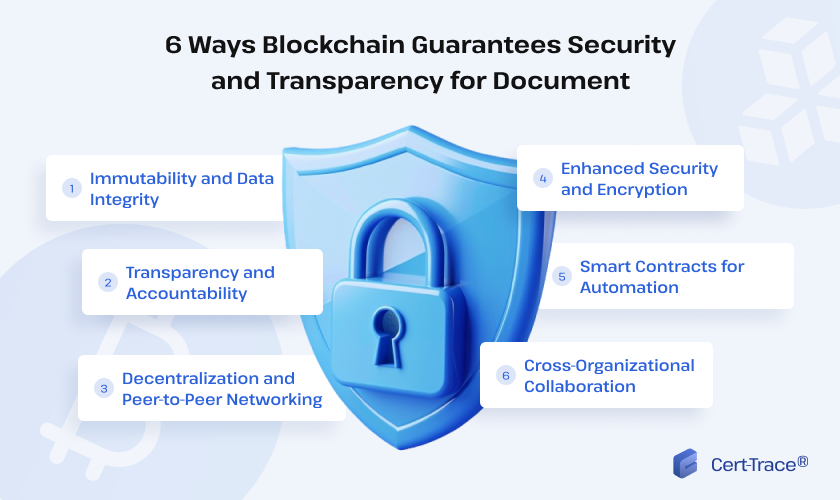
Bill Holler
CEO at Cert-Trace®
The internet offers many different options for document storage, but every story about data leaks or hacks is a reminder that while convenience and flexibility are huge benefits, they should never come at the expense of security.
So, can blockchain be used to deliver genuinely secure document archiving and storage? In this guide we’ll cover everything you need to know about blockchain security for document storage including questions like ‘why is blockchain secure?’ and ‘what makes blockchain secure?’
Why can users adopt blockchain to secure document digitization?
Blockchain is still best known for its use in cryptocurrency trading, but the features that make it ideal for recording transactions also make it easy to use for ensuring security in other uses. This includes document storage, where the security of blockchain can be leveraged to ensure the integrity of crucial data and protect them from unauthorized access.
We’ll explore how blockchain security for document storage works in the next section, but before we do, what are some examples of how this technology can be used to secure document digitization?
One obvious use case would be in the world of healthcare, where patients’ medical records need to be kept completely secure and private but can also need to be shared with fellow professionals, potentially around the world. Blockchain network security can make this possible.
Equally, it can be used for storing and sharing confidential financial documents, business contracts and for document archiving where files need to be stored securely in the long term. As document digitization becomes ever more standard, even for creating archives, blockchain has a huge role to play.
How Blockchain Guarantees Security and Transparency for Document Storage
So what is it about the concept of blockchain that makes it so ideal for security? Here are some of the key aspects that make up blockchain security that you should consider.

1. Immutability and Data Integrity
One of the most important aspects of the blockchain algorithm for security is the concept of immutability. If you’re not sure what that means, it’s basically the state or condition of being unchangeable. If you store a document in a cloud server, it is most likely going to be editable, so anyone who gains access can change it.
Blockchain is a distributed and decentralized ledger where blocks are added to a chain with references connecting them, ensuring the integrity of the whole chain. Once data is recorded on that blockchain, it can only be altered with the consensus of all of the participants in that network, so you can rely on that data being unchanged. Its integrity is beyond question because of the very nature of blockchain.
2. Transparency and Accountability
Having this network of participants means that there’s a huge amount of transparency in blockchain, which is another major plus when it comes to security. Every person involved in the network is able to track every detail of a data transfer process, from the origin to the destination and exactly who was involved.
Crucially, this visibility and accountability helps to engender trust amongst everyone involved, breaking down any lingering doubts about whether blockchain is a secure way to store and transfer sensitive data. After all, if everyone can see everything, then nothing is being hidden.
3. Decentralization and Peer-to-Peer Networking
Another risk associated with cloud storage is that, while the name suggests that your documents are floating in the ether, they’re actually stored on central servers somewhere. This can result in single points of failure that are more susceptible to data breaches. If someone gets into a shared server, they can access anything that’s on it.
Because blockchain uses decentralized peer-to-peer networking, there is no potential single point of failure – the chain can stay secure even if one point of it is compromised. This system has other advantages, including removing the need for intermediaries, which saves money and removes another element of risk.
4. Enhanced Security and Encryption
The way that it works also helps when it comes to blockchain encryption. This works so effectively because the files are encrypted by breaking them up into chunks that are distributed across the network. So if someone DOES manage to hack into one of the nodes, they still won’t have access to any complete files, so the information they can find is useless to them.
As well as this blockchain encryption, another strength of this collective power is the ability to ensure that invalid transactions don’t make it onto the chain because they wouldn’t be able to achieve consensus from all participants, thus maintaining the integrity of the blockchain and the data stored within.
5. Smart Contracts for Automation
A key aspect of blockchain’s use in cryptocurrency is smart contracts, which are written into the code and can be used to automate processes. This can translate into effective and secure transfers of data as well as Bitcoin. Automating removes the risk of human error or the interference of unauthorized people, as well as lowering overheads and making the whole process more efficient.
6. Cross-Organizational Collaboration
Our last point here is that blockchain’s collaborative nature can work especially well in industries where that kind of collaboration between organizations is common. The immutability, encryption and decentralization can help build trust between organizations that the data being transferred is being done securely and accountably, with all actions logged and tracked for all to see.
This removes the potential for errors, misunderstandings, mistrust and disputes arising over the way documents are stored, shared or amended, helping supply chains keep moving, encouraging academic researchers to pool their research and solving countless other issues across many industries.
Benefits of blockchain for secure document management for any industry
We’ve already made it clear that blockchain security for document management brings plenty of advantages because it can make use of the algorithms, encryptions and basic set of this kind of technology.
It is ideal for protecting sensitive information because it is so much harder for anyone to access it if they aren’t meant to. No-one can successfully hack into the data or make any changes to it, so that sensitive data will stay protected.
It also makes sharing data and documents securely much more reliable. If you’ve ever had to send a document from your organization’s cloud server to someone from another organization, you’ll know how this process is far from seamless or secure. Blockchain makes this much more straightforward without any kind of compromise around security.
And of course, the immutability of blockchain helps protect you from one of the biggest threats to your data – human error. No-one can accidentally delete, edit, copy over or duplicate data if it is stored in blockchain, so you can rest easy, knowing that it is safe and protected in a way that no amount of data security policies and procedures could guarantee.
Conclusion
As you’ll have seen above, blockchain comes with many benefits for safely and securely storing data, making it the future for document storage. Whatever industry you are involved in, there will always be documents that need archiving or storing securely and while cloud storage has its benefits, it also comes with too many risks that can be resolved easily with blockchain.
If you want to find out more about what blockchain storage can do for your data security, why not get in touch with any questions at info@tracert.digital.
How useful was this post?
Click on a star to rate it!
Average rating 5 / 5. Vote count: 531
No votes so far! Be the first to rate this post.

